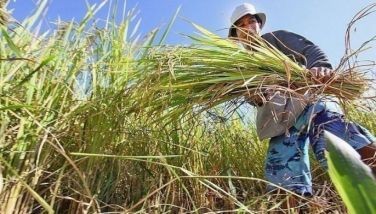Keeping RP bird flu-free
November 27, 2005 | 12:00am
The Philippines is a bird flu-free country, thanks mainly to government policies as laid down by President Arroyo and Agriculture Secretary Domingo Flores Panganiban.
Measures have been launched to protect. The country’s poultry industry and the population from H5N1 which authorities fear may mutate, acquiring genes from human influenza virus. It has already claimed 60 lives in Asia.
President Arroyo has sought permission from World Health Organization (WHO) to manufacture drugs against avian flu (Tamiflu) in her visit to Olango Island where migratory birds from Siberia, Northern China and Siberia stay. She said: "It is important for us to continue to protect the country from the avian flu it’s been in the region of Asia in the last two years but the Philippines through cooperation among the government agencies and non-government organizations has been spared."
Panganiban as head of the National Avian Influenza Task Force (NAITF) has stengthened bird flu protection program by involving all agencies to protect the Philippines from this deadly disease.
The other agencies are: the Department of Health, Department of Environment and Natural Resources, Department of Interior and Local Government, National Disaster Coordinating Council, Depatment of Foreign Affairs, Game and Amusement Board, Department of Labor and Employment, Department of Education and Culture, Department of National Defense, Office of the Press Secretary, Philippine Coast Guard and Philippine National Police.
What should be done? (1) Prevent direct or indirect contact of domestic flocks with migratory birds and waterfowls by keeping them inside poultry farmhouses; (2) Prevent direct contact with discharges from migratory birds and waterfowls, especially feces and respiratory secretions. The disease can spread easily through contaminated feed, water, cages, equipment and clothing; (3) Do not catch migratory birds from the black market.
(4) Vaccinaton of birds in breeding farm is highly recommended; (5) Report to DENR for birds, or to DA for domestic poultry suspected to be infected with the virus.
Signs and symptoms of a sick bird: (1) Swollen legs; (2) Sneezing, coughing, with nasal discharges; (3) With fever and diarrhea; (3) Lost appetite; Excessive thirst; (4) Crown and wattle turn purple; (5) Ruffled fethers; (6) Sudden death.
Sign and symptoms of human infected with bird flu: fever, body weakness or muscle pain, coughing, sore throat, difficulty in breathing in sever cases, sore eyes.
Measures have been launched to protect. The country’s poultry industry and the population from H5N1 which authorities fear may mutate, acquiring genes from human influenza virus. It has already claimed 60 lives in Asia.
President Arroyo has sought permission from World Health Organization (WHO) to manufacture drugs against avian flu (Tamiflu) in her visit to Olango Island where migratory birds from Siberia, Northern China and Siberia stay. She said: "It is important for us to continue to protect the country from the avian flu it’s been in the region of Asia in the last two years but the Philippines through cooperation among the government agencies and non-government organizations has been spared."
Panganiban as head of the National Avian Influenza Task Force (NAITF) has stengthened bird flu protection program by involving all agencies to protect the Philippines from this deadly disease.
The other agencies are: the Department of Health, Department of Environment and Natural Resources, Department of Interior and Local Government, National Disaster Coordinating Council, Depatment of Foreign Affairs, Game and Amusement Board, Department of Labor and Employment, Department of Education and Culture, Department of National Defense, Office of the Press Secretary, Philippine Coast Guard and Philippine National Police.
What should be done? (1) Prevent direct or indirect contact of domestic flocks with migratory birds and waterfowls by keeping them inside poultry farmhouses; (2) Prevent direct contact with discharges from migratory birds and waterfowls, especially feces and respiratory secretions. The disease can spread easily through contaminated feed, water, cages, equipment and clothing; (3) Do not catch migratory birds from the black market.
(4) Vaccinaton of birds in breeding farm is highly recommended; (5) Report to DENR for birds, or to DA for domestic poultry suspected to be infected with the virus.
Signs and symptoms of a sick bird: (1) Swollen legs; (2) Sneezing, coughing, with nasal discharges; (3) With fever and diarrhea; (3) Lost appetite; Excessive thirst; (4) Crown and wattle turn purple; (5) Ruffled fethers; (6) Sudden death.
Sign and symptoms of human infected with bird flu: fever, body weakness or muscle pain, coughing, sore throat, difficulty in breathing in sever cases, sore eyes.
BrandSpace Articles
<
>
- Latest
Latest
Latest
March 27, 2025 - 2:48pm
March 27, 2025 - 2:48pm
March 26, 2025 - 3:46pm
By Dominique Nicole Flores | March 26, 2025 - 3:46pm
February 28, 2025 - 11:26am
By Dominique Nicole Flores | February 28, 2025 - 11:26am
February 24, 2025 - 6:28pm
By Dominique Nicole Flores | February 24, 2025 - 6:28pm
February 19, 2025 - 7:28pm
By Dominique Nicole Flores | February 19, 2025 - 7:28pm
Recommended





























